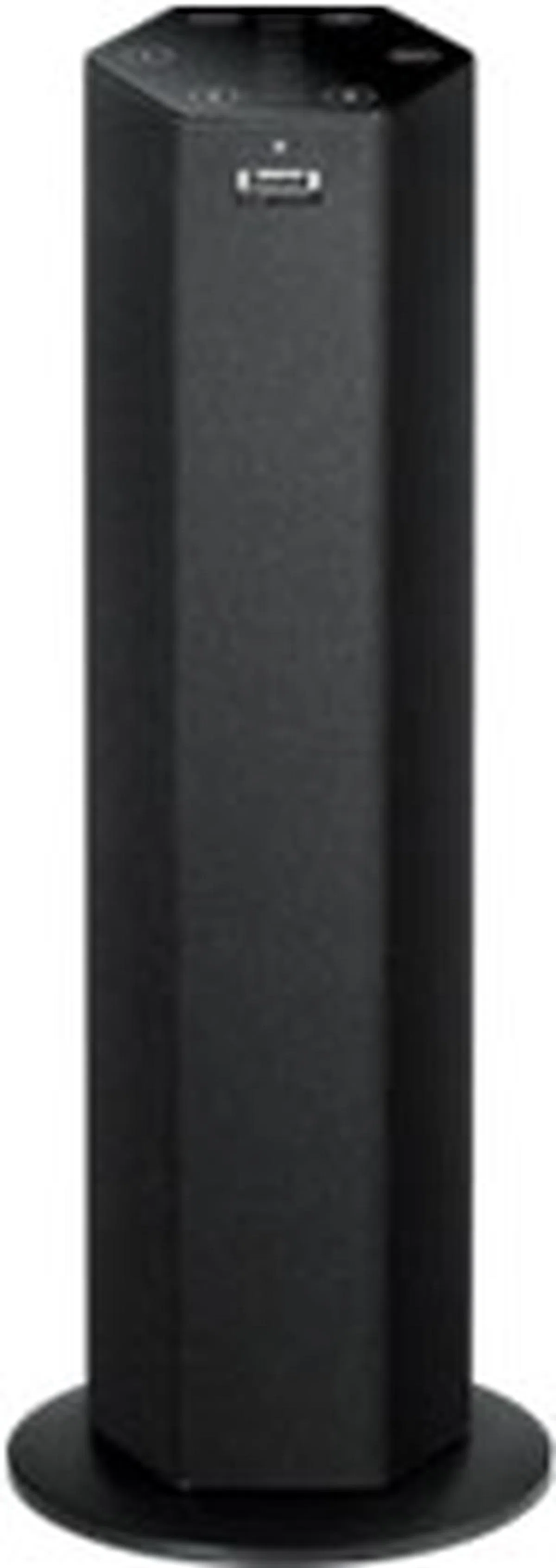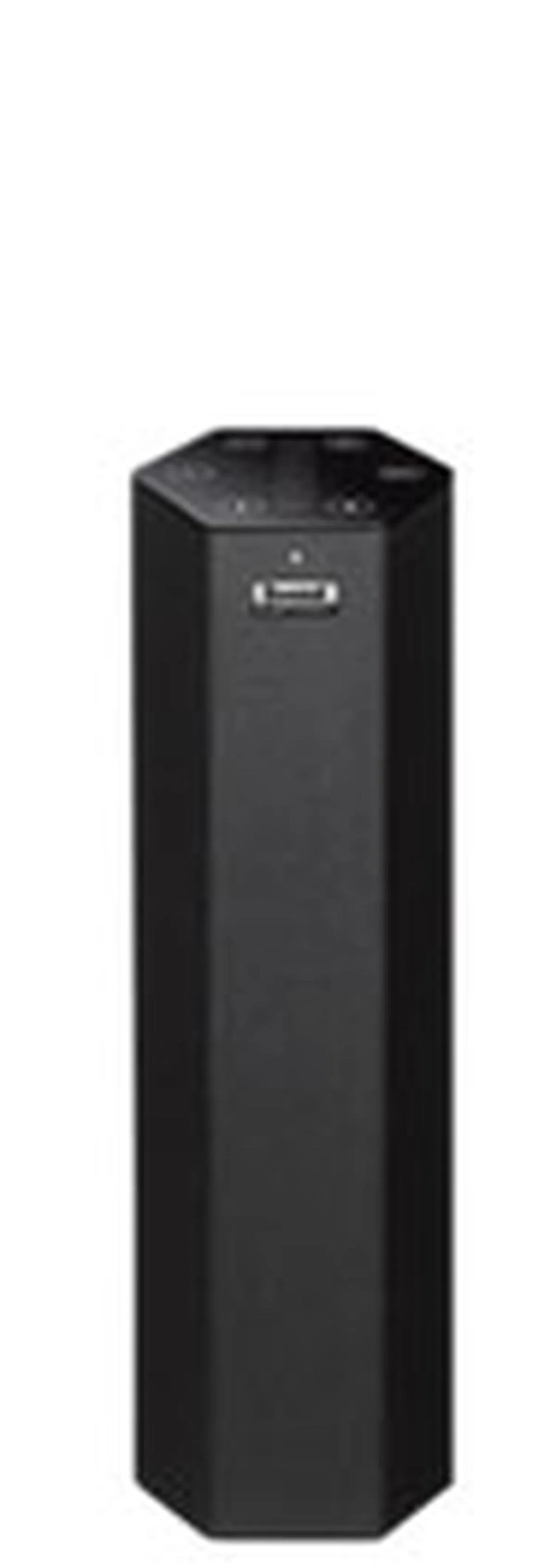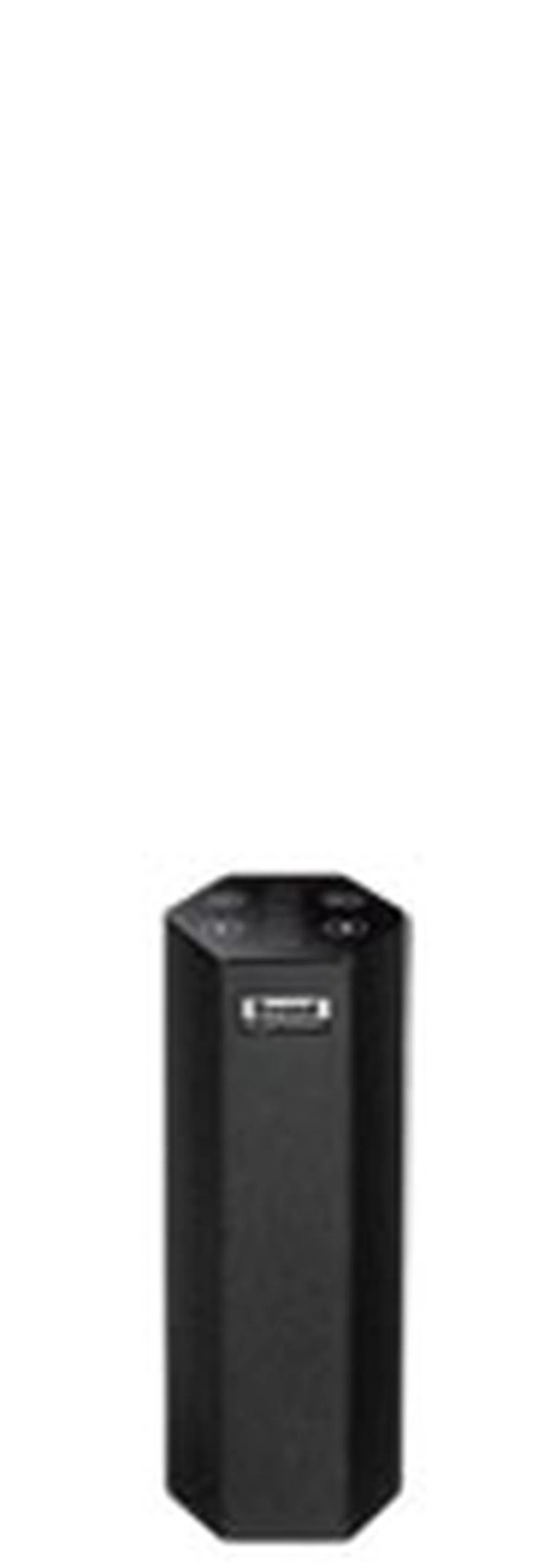The Creative Sound BlasterAxx Speaker Family - Heralding a New Era for Creative
The new Creative Sound BlasterAxx is unlike any wireless speaker. It features a host of smart features such as a customizable "acoustic zone" and even boasts a built-in microphone array with CrystalVoice technology for communication purposes. We check out the entire line-up, SBX 8, SBX 10 and SBX 20, to see if it will turn Creative's fortunes.
By Kenny Yeo -
A New Kind of Creative
Much has been said about Creative’s recent efforts. Ever since generic sound cards were made redundant by onboard audio ICs (integrated circuits), the company has dabbled in all sorts of endeavors but without any real success. At least not the kind they enjoyed in the early 90s with their Sound Blaster sound cards.
To turn around the company's fortunes, Creative recently announced their new Sound BlasterAXX wireless speakers, which Creative proudly proclaims as a "technological marvel". The Sound BlasterAxx speakers marks a new generation of products from Creative that their CEO Sim Wong Hoo promises to be, and we quote, "elegantly designed and easy to use". No longer will they make "kitchen sink" types of products with too many features and too difficult to use. Creative wants to streamline and give focus to their products.
As for the new Sound BlasterAxx wireless speakers, they will come in three differently-sized models - SBX 20, SBX 10 and SBX 8, with the SBX 8 being the smallest. The speakers are chock-full of new technologies and features. To begin, the 40cm tall flagship SBX 20 has a special high-efficiency intelligent amplifier that ensures it can be driven solely via power from a USB cable. In fact, in our short hands-on preview session with the speakers earlier at Creative’s HQ, we found that each of the speakers can be powered by a single USB battery pack, and they didn’t sound weak or breathless at all.

The new Sound BlasterAxx marks a new generation of Creative products that their CEO Sim Wong Hoo promised will be "elegantly designed and easy to use".
Also unique to the Sound BlasterAxx is that the speakers also boasts microphones. The SBX 20 and SBX 10 will have dual-array microphones, while the SBX 8 will only have a single microphone. These microphones lets users use the speaker to communicate as if its a hands-free kit. It also helps that the Sound BlasterAxx has their CrystalVoice suite of noise-canceling technologies to ensure the utmost voice call clarity.

Digital sound and voice processing is handled by the multi-core Sound BlasterAxx SB-Axx1 chip.
How can a single wireless speaker pack so much feature? This is all possible thanks to the Sound BlasterAxx’s SB-Axx1 chip - a multi-core voice and audio effects processor. This processor boosts audio and voice quality and also handles the Sound BlasterAxx’s noise reduction technologies that enables voice calls that are, in Creative’s own words, “second to none”.
In all, the Sound BlasterAxx is one of the more interesting products we’ve seen in recent times, combining the functions and features of a wireless speaker as well as a hands-free kit. But while it sounds intriguing and promising on paper, how does it perform it the real world? Read on to find out.
Introducing the Sound BlasterAxx
The new Sound BlasterAxx speakers comes in three different sizes and all of three of them follow a simple hexagonal tower design. It’s a simple and elegant design that lives up to Creative CEO Sim Wong Hoo’s earlier claims that from now on all Creative products would be "elegantly designed".
The smaller SBX 10 and SBX 8 models are very compact and take up very little space on a desk. The larger SBX 20 flagship is a little tricky though because at 40cm it is pretty tall and requires a stand to stabilize it. As such it takes up slightly more desk space. Even so, its height makes it look awkward on a desk; on the other hand, we think it looks too small to be floor-standing speakers too. For users who are fussy with positioning and placement, finding a suitable spot for the SBX 20 will take a bit more work and creativity. For those wondering if it's the tallest PC speaker yet, if you recall a seriously bulky and tall speaker set from Altec Lansing called the ACS500 from the 1990s, that's actually taller at 46cm! So the Creative SBX 20 is certainly not the tallest, but it comes close.
The Sound BlasterAxx utilizes what Creative calls a "Stacked Stereo Acoustic Design" that combines two full-range speaker drivers vertically into a single chassis. The two speakers are also slightly angled to give better stereo separation and a wider sound soundstage, a common weakness of single unit stereo speaker systems. Also, for the SBX 20 and SBX 10, the speakers also has a dual-mic array, which uses two microphones to accurately pick up voice and intelligently adjusts audio.
In terms of features, the SBX 20 and SBX 10 are nearly identical. The only difference being that the larger SBX 20 has Creative's specially-designed intelligent amplifier that allows it to be powered via USB - the SBX 10 and SBX 8 which have smaller drivers do not have such high power requirements and as such are not equipped with this amplifier.
The baby SBX 8 also lacks Bluetooth connectivity too, so it cannot play music wirelessly and must be connected to the source either via USB or the auxiliary jack. It is also missing Creative's VoiceFocus technology (which we'll discuss in later pages). This is a little weird seeing that the most portable unit actually lacks the most useful of functions ideal for on-the-go usage.
Here's a round up of the speakers' sizes and features:
Model | Height | Driver Size | Intelligent Amplifier | Bluetooth | SBXPro Studio | CrystalVoice Technology |
SBX 20 | 40cm | 2.75-inch | Yes | Yes | Yes | Yes |
SBX 10 | 30cm | 2.25-inch | No | Yes | Yes | Yes |
SBX 8 | 16 cm | 1.4-inch | No | No | Yes | Yes (No VoiceFocus) |

A side by side comparison of the models in the Sound BlasterAxx lineup. The smallest SBX 8 model is no bigger than a 2.5-inch portable hard drive.

The taller profile of the SBX 20 makes a stand necessary. All three models have a rear bass reflex port, auxiliary jack, headphone hack and mini-USB port (for audio and power). However, only the SBX 20 and SBX 10 have a button to activate Bluetooth pairing. The SBX 8 doesn't have Bluetooth functionality.

All three models have a resistive touch panel on the top of the speakers for control. With it, you can adjust the volume and activate (or deactivate) the various sound and noise technologies such as SBX Pro Studio and VoiceFocus.
Setting Up
The Creative Sound BlasterAxx was designed to work with both Macs and PCs and for the purpose of this review, we’ve decided to pair the speakers with a MacBook Pro since it offers both Bluetooth and USB connectivity with which we can test the speakers. Do not that Bluetooth connectivity is not offered on the baby SBX 8 model.
To the test Sound BlasterAxx, we will be using our usual suite of MP3 test tracks which are as follows:
- Hotel California - The Eagles
- Sail on Soothsayer - Buckethead
- Melt My Heart to Stone - Adele
- Elements of Life - Tiesto
We have also tested the Sound BlasterAxx with a variety of other tracks, but more emphasis will be placed the core tracks listed above for scoring purposes. Of course, as we have long maintained, audio is a subjective matter and one man’s meat could be another man’s poison. Nevertheless, we retain a neutral approach during our listening so as not to let our personal preference cloud our judgment.
Setting up the Sound BlasterAxx SBX 20 and SBX 10 on our MacBook Pro either through USB or Bluetooth was a breeze. Once selected as the main audio device, the Sound BlasterAxx will immediately begin playing music. However, to really take advantage and make use of the Sound BlasterAxx’s wide range of abilities, downloading and installing the Sound BlasterAxx Control Panel (available for PC, Mac, iOS and Android) is highly recommended.
The software suite will let you configure your Sound BlasterAxx device and set it up for your different needs. The software has its quirks though. For the Mac version, you can only use the software suite when the speakers are connected via USB and not Bluetooth. If you try to use it while the speakers are connected to your Mac via Bluetooth, you will get an error message saying that the audio device supported by the application cannot be detected. This somewhat limits the use of the Sound BlasterAxx as a wireless speaker for your PC or Mac especially if you want to tinker around the various speaker settings.

The Sound BlasterAxx control panel gives a great degree of control over the speakers. You can even tweak individual settings with SBX Pro Studio such as the amount of bass boost, the crossover frequency, having "Surround" on while turning "Crystalizer" off etc.

The iOS app equivalent is just as full featured. However, it was a little clumsy to use as the controls are not very intuitive. You do get the hang of it after a little while though.
Audio Performance
To test the new Sound BlasterAxx we loaded up our usual suite of MP3 test tracks (as mentioned on the earlier page) and also used an assortment of other accompanying tracks to get gauge of how the speakers perform. We also tested them in both wired (USB) and wireless (Bluetooth) mode. We begin first with our analysis of the flagship SBX 20.
The SBX 20
The Sound BlasterAxx SBX 20 is the flagship model of the series and is also the largest, standing at 40cm tall. On first impressions, the SBX 20 sounded much more full bodied and powerful than we would expected from a speaker of its size.
The SBX 20 sounded pretty well-rounded and has sufficient clear highs and a fairly warm mid-range. Vocals had sufficient clarity and we found Adele’s vocals on Melt My Heart to Stone to be well textured and warm. However, we also noticed that like many other Creative speakers we’ve listened to, it has a rather prominent emphasis on bass. Bass notes received more slightly more emphasis, and this was especially so when we enabled SBX Pro Studio surround technology. In fact, with SBX Pro Studio enabled, the SBX 20 became slightly too bass heavy, especially on dance tracks. Fortunately, the Creative Sound BlasterAxx Control Panel allows you to turn off bass boost and adjust the level of bass boost so that you can reduce its emphasis on the SBX 20. For advanced users, you can even set the crossover frequency.
The important question is, can it still project a good stereo effect when it lacks a physical separation of its two audio drives like in normal speaker systems? Unfortunately, despite enabling the SBX Pro Studio surround technology, there’s little in the way of stereo separation from the SBX 20. It cannot convincingly replicate the sound of a stereo system setup and still sounds like a single speaker. However, it does throw its sound very well. As such, it’ll fill a room with sound easily and effortlessly. If anything, SBX Pro Studio helps it produce a less harsh sound.
The SBX 10
The SBX 10 sounded a tad less impressive than its bigger SBX 20 sibling. Without SBX Pro Studio enabled, it sounded a little dull and flat and much less lively and eager than the SBX 20. Fortunately, activating SBX Pro Studio improved things significantly and gave the SBX 10 a much edgier and energetic sound. Vocals were more distinct and bass notes were more hard hitting. That said, like the SBX 20, we found that we needed to tweak the bass boost of the SBX Pro Studio to get the best sounding results because if we left it in default, the bass was far too boomy. Also, unlike the SBX 20, the smaller SBX 10 exhibited some tendency to distort at higher volume levels. Overall, considering the rather compact size of the SBX 10, we were surprised by the sheer volume of its sound and also its quality (even if it meant enabling SBX Pro Studio).
The SBX 8
Lastly, we come to the baby of the range, the SBX 8. The SBX 8 is the smallest of the trio at around 17cm tall, but despite its petite size, we were pleasantly surprised by its sound. For a speaker not much bigger than a portable hard drive, the SBX 8 sounded full-bodied and authoritative. It definitely sounded like it came from a much bigger speaker.
Like its bigger siblings, the SBX 8 had a well-rounded and warm mid-range. We noted, however, that its highs weren’t as transparent and clear and vocals sounded more muffled. With SBX Pro Studio activated, the SBX 8 sounded more aggressive and edgier. The treble was significantly harder-hitting. Unfortunately, for the SBX 8, activating SBX Pro Studio also made its bass boomy and lethargic. Luckily we can rectify this by tweaking its settings within the Sound BlasterAxx control panel. All in all, considering the diminutive size of the SBX 8, its audio performance certainly impressed us.
Overall Thoughts
The Sound BlasterAxx are good sounding speakers with a warm and full-bodied mid-range, clear and transparent highs. However, its bass performance is a little erratic especially with SBX Pro Studio enabled. This can however be corrected using the Sound BlasterAxx control panel application. We also liked that the speakers threw its sound very well. It sounded very expansive and easily fills a room with sound. However, like so many single speaker systems, stereo separation was poor.
Playback over Bluetooth on the SBX 20 and SBX 10 was also good as there was no discernible drop in audio quality. Playback was also smooth and drop outs were infrequent.
MP3 Testing | SBX20 Score | SBX10 Score | SBX8 Score |
Hotel California - The Eagles | 8 | 8 | 8.5 |
Sail on Soothsayer - Buckethead | 8.5 | 7.5 | 8.5 |
Melt My Heart to Stone - Adele | 8.5 | 8 | 8.5 |
Elements of Life -Tiesto | 8 | 7.5 | 8.5 |
Using CrystalVoice
Apart from audio performance, we also tested and tried out the Sound BlasterAxx’s other features. Since the Sound BlasterAxx is also positioned as a hands-free calling device, we tested the call qualities of the Sound BlasterAXX.
With the Sound BlasterAXX, Creative has introduced their CrystalVoice suite of technologies. One of the primary aims of CrystalVoice is to improve the quality of conversations and so one of the features of CrystalVoice technology is noise reduction, which helps eliminate background noises such as passing vehicles; and also acoustic echo cancellation, which reduces echoes. We found that the noise-canceling capabilities of the Sounder BlasterAxx was pretty much a hit and miss affair. In one instance, we left a vacuum cleaner on in our surroundings and we found that the Sound BlasterAxx did well to reduce the racket it caused; but at the same time, we could still hear some echo in our calls.

The Sound BlasterAxx Control Panel lets users tweak voice calls too. You activate (and deactivate) noise reduction, acoustic echo cancellation, VoiceFocus and also VoiceFX to change your voice into that of someone or something else.
Moving on, one of the more interesting features is what Creative calls VoiceFocus. With it, the Sound BlasterAxx creates a zone and suppresses any noise outside of this zone. However, this feature is available only on the larger SBX 20 and SBX 10 models. In our testing, we found that even if you move out of the zone, the microphone will still pick up your voice if you are close and loud enough.
Another benefit of CrystalVoice is Smart Volume. With Smart Volume enabled, the Sound BlasterAxx automatically adjusts your volume to maintain a consistent level so even if you move away from the Sound BlasterAxx, you needn’t have to raise your voice to be heard. While this certainly sounds good on paper, in practice, we found that Smart Volume doesn’t work too well. We found that the voice would get softer as you move away from the Sound BlasterAxx, though not to quite the same extent as it would have if we had disabled Smart Volume.
Lastly, CrystalVoice also includes sound effects that lets you alter your voice. It can change your voice from male to female or vice versa, give you an abnormally deep voice, or make you sound like an orc, robot or alien. The feature works well enough and we think it could be fun to use it on pesky telemarketers!
Redemption for Creative
With the new Sound BlasterAxx speakers, Creative CEO Sim Wong Hoo hopes to usher in a new era for the company. As we’ve mentioned earlier in our article, not only does he want new Creative products to be more focused in their use, he also wants them to be well designed and easy to use. These qualities, he said, will be the ones Creative will strive for, and the trio of Sound BlasterAxx speakers heralds this new generation of Creative products.
That said, we can’t help but wonder is Creative if holding true to its words, because apart from speakers, these new products also double up as microphones. That’s not to say that they are bad, the ability to perform the double functions of both a speaker and microphone is certainly nifty, but wasn't being more focused one of Creative's goals? Furthermore, we are not entirely convinced that users would take into consideration the fact that these speakers can double up as microphones as one of their purchasing decisions. On top of that, while the new speakers were easy to setup, we found that the Sound BlasterAxx control panel application to be a bit confusing to use.
Thankfully, the new Sound BlasterAxx works well as both a speaker and a microphone. Aurally, we found the speakers to have the same signature as the Gigaworks T3 (as reviewed in our great 2.1 speaker shootout), with a warm mid-range and clear highs. Unfortunately, like the Gigaworks T3, the new Sound BlasterAxx speakers (especially the SBX 10 and SBX 8) also suffer from bloaty bass, especially when SBX Pro Studio is enabled. Thankfully, that can be rectified by going into the Sound BlasterAxx Control Panel and tweaking with the bass settings. The SBX 20 and SBX 10 also worked well wireless in Bluetooth mode, as we did not notice any discernible drop in audio quality.

A new era for Creative? The new Sound BlasterAxx speakers certainly provide well, but we can't help but think that it still tries to be too many things at one time.
Of the trio, the flagship SBX 20 was undoubtedly the best sounding. Thanks to its size, its bass was more well-controlled and it highs and mids were more transparent and well-rounded. The SBX 10 is a bit of an oddball, because without SBX Pro Studio enabled, we found that it sounded noticeably duller and flatter than the SBX 20. The one we were most impressed with, however, has got to be the baby SBX 8. For a speaker not much larger than a portable hard drive, we were thoroughly blown away by its sheer output and also audio quality.
Audio performance aside, the new Sound BlasterAxx speakers also doubled up as capable microphones. Although we did notice that there were echoes at times, Creative’s CrystalVoice noise-cancelation technologies generally worked well enough to significantly reduce ambient noise. However, features such as VoiceFocus and Smart Volume requires further tweaking as we found them to be pretty erratic. Overall, these speakers will be handy for those who chat on Skype often or just as a hands-free kit for their iPhones and Android phones.
Overall, the Sound BlasterAxx speakers are an interesting and competent addition to Creative’s stable of products. Good audio performance aside, they also double up as capable microphones with noise-canceling technologies. Here's a breakdown of how each speaker scored from our testing:-
Model | Design | Features | Performance | Value | Overall |
SBX20 | 8.0 | 8.5 | 8.5 | 7.5 | 8.0 |
SBX10 | 8.5 | 8.5 | 7.5 | 7.0 | 7.5 |
SBX8 | 8.5 | 8.0 | 9.0 | 9.0 | 9.0 |
As for individual ratings, the SBX 20, despite its excellent audio performance and wide array of features, is penalized for its undefined positioning. At 40cm tall, we are not sure if it is positioned as a desktop or standalone floor speakers. And even if it can be powered by a single USB battery pack, it is not as portable as the smaller SBX 10 and SBX 8. The SBX 20 performs well, but it’s just not clear what it is intended for. This problem is compounded when you think that at S$279, it faces stiff competition from dedicated desktop speaker systems and wireless docking systems such as Creative’s own Gigaworks T3 and Ziisound D5 respectively. One aspect where the SBX 20 would come in handy is for those specifically looking for a decent room audio solution that occupies the least amount of desk/floor space (hence it's tower design comes as an advantage) and yet has the volume to keep its listeners content.
The SBX 10 comes in at an overall 7.5 rating as it sounded noticeably less bright and impactful if we left SBX Pro Studio deactivated. Like the SBX 20, users who have no need for the SBX 10’s microphone capabilities, they might be tempted to look at other alternatives, especially since we think it’s a bit pricey at S$199 for its capabilities.
The baby SBX 8 gets a solid 9.0 for its impressive audio capabilities in its petite form factor. Its sound belies the fact it only stands 16cm tall. And although it lacks many of features of its bigger siblings, such as Bluetooth connectivity and VoiceFocus, its sheer audio performance more than made up for it. Furthermore, at S$129 we think its pretty reasonably priced considering all it offers. It could only have been better had it also featured the missing features.
Our articles may contain affiliate links. If you buy through these links, we may earn a small commission.





